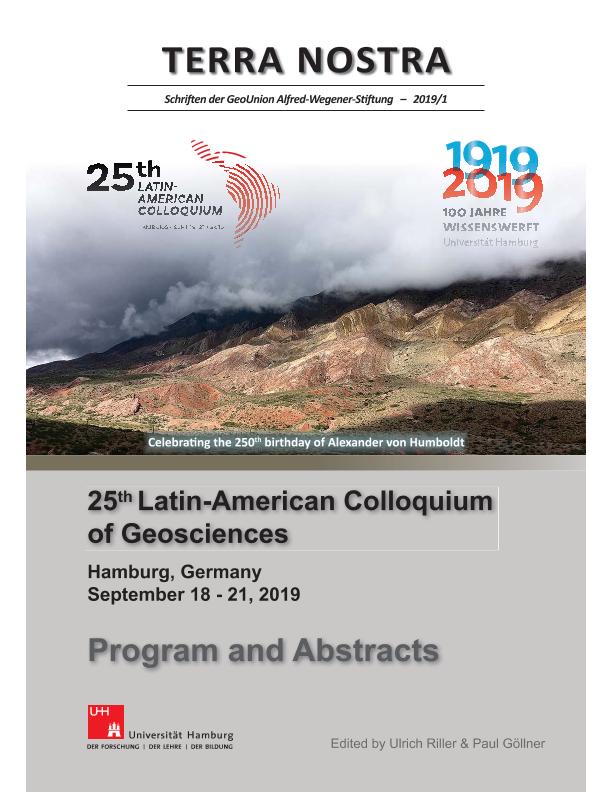Evento
P-T-d path of a garnet-bearing metagranite from the Paleoproterozoic basement of the Tandilia terrane, Rio de la Plata craton, Argentina
Colaboradores:
Riller, Ulrich; Göllner, Paul
Tipo del evento:
Otro
Nombre del evento:
25th Latin-American Colloquium of Geosciences
Fecha del evento:
18/09/2019
Institución Organizadora:
Universität Hamburg;
Título de la revista:
Terra Nostra
Editorial:
GeoUnion Alfred-Wegener-Stiftung
ISSN:
0946-8978
Idioma:
Inglés
Clasificación temática:
Resumen
The Tandilia Terrane (TT), in central-eastern Argentina and southeastern Uruguay (Pamoukaghlian et al., 2017), is a Paleoproterozoicigneous-metamorphic complex that represents the southernmost expositions of theRio de la Plata craton (RPC). The study area includes the small outcrops of theLa Virgen hill, western TT, mainly composed of a garnet-bearing granite. As wewant to constraint the P-T-d evolution path of this granite, the appraisal ofmicrostructures was integrated to a P-T pseudosection modeled with the PERPLE_Xsoftware for a selected bulk-rock composition in the 11-component systemSi-Ti-Al-Fe-Mn-Mg-Ca-Na-K-O-H, and to various contoured chemical parameters ofinterest. The analyzed rock is a slightly deformed, peraluminous (ASI= 1.07),grey granite composed of (~ vol.%): K-feldspar (37), quartz (30), plagioclase(18), biotite (7), garnet (5), muscovite (2), zircon, apatite, monazite andopaque minerals as accessory phases (1). The porphyroclastic texture, withdevelopment of core-and-mantle, is characterized by a 15 vol.% of fine-grained granoblastic matrix. The derived P-T path is as follows: the garnet corecomposition of pyr4(gro+andr)12spes10alm74,equilibrated with andesine (XAn = 0.37), yielded P-T conditions of 6 kbar and 650°C (Fig. 1, point A) near the melt out curve (~7 vol.% of melt).The stable mineral assemblage at these conditions is Ms+Pl+Kfs+Ilm+Üsp+Grt+Bt+Qtz, as in the natural rock. Garnet recorded a rimward decreased in pyrope from 4 to 3 mol% by slow cation diffusion until its out stability limit is reached at 5.5 kbar and 620°C (Fig. 1, point B). The subsequent path is fairly constrained between isopleths of 3.09-3.17 Si (pfu)in muscovite and XAn = 0.36 in plagioclase. The deciphered evolution path in the studied rock demonstrates the cooling down of a near solidus granitic material during exhumation from the middle crust (22 km), under an apparent geotherm of ~ 30 °Ckm-1, until upper crustal conditions of ~7 km. The ductile microstructures of deformation in the protomylonitic granite are consistent with others microstructures observed in feldspars (deformation twins, myrmekites and flame perthites) which for the 1.5 km distant granitic rock of the Siempre Amigos area were restricted between 650 °C and 430 °C (Angeletti et al., 2016). The exhumation path suggested for the studied peraluminous granite is similar to the garnet-bearing leucogranite of San Veran hill, sited 100 km to the SE of the study area, which was related to a postcollisional stage of the Trans-Amazonian orogeny cycle (Martínez et al. 2017).
Palabras clave:
GEOTERMOBAROMETRÍA
,
PETROLOGÍA
,
CRATON RÍO DE LA PLATA
,
EVOLUCIÓN GEOLÓGICA
Archivos asociados
Licencia
Identificadores
Colecciones
Eventos(INGEOSUR)
Eventos de INST.GEOLOGICO DEL SUR
Eventos de INST.GEOLOGICO DEL SUR
Citación
P-T-d path of a garnet-bearing metagranite from the Paleoproterozoic basement of the Tandilia terrane, Rio de la Plata craton, Argentina; 25th Latin-American Colloquium of Geosciences; Hamburgo; Alemania; 2019; 28-29
Compartir
Altmétricas




